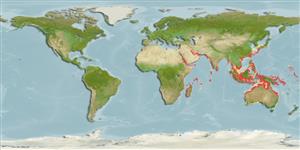Bivalvia |
Cardiida |
Cardiidae
Environment: milieu / climate zone / ระดับความลึก / distribution range
นิเวศวิทยา
; กร่อย, usually 0 - 25 m (อ้างอิง 75831). Tropical
Indo-West Pacific: Reported from East Africa, including South Africa and the Red Sea, to southern Japan, the Philippines, and eastern Indonesia.
Length at first maturity / ขนาด / Weight / Age
วัยเจริญพันธุ์: Lm ? range ? - ? cm Max length : 6.0 cm SHL เพศผู้/กระเทย; (อ้างอิง 348); common length : 5.0 cm SHL เพศผู้/กระเทย; (อ้างอิง 348)
The distribution of this species is imperfectly known because of frequent confusion with other species of the genus (Ref. 348). Found in intertidal areas, in mud and sand, (Ref. 75831) and shallow sublittoral waters (Ref. 348). In sheltered bays and estuaries (Ref. 348).
Life cycle and mating behavior
วัยเจริญพันธุ์ | การสืบพันธุ์ | การวางไข่ | Eggs | ความดกของไข่ | Larvae
Members of the class Bivalvia are mostly gonochoric, some are protandric hermaphrodites. Life cycle: Embryos develop into free-swimming trocophore larvae, succeeded by the bivalve veliger, resembling a miniature clam.
Poutiers, J.M. 1998 Bivalves. Acephala, Lamellibranchia, Pelecypoda. p. 123-362. In Carpenter, K. E. and V. H. Niem. 1998. FAO species identification guide for fishery purposes. The living marine resources of the Western Central Pacific. Volume 1. Seaweeds, corals, bivalves, and gastropods. Rome, FAO. (อ้างอิง 348)
IUCN Red List Status
(อ้างอิง 130435: Version 2025-1)
CITES status (อ้างอิง 108899)
Not Evaluated
CMS (อ้างอิง 116361)
Not Evaluated
Threat to humans
Harmless
Human uses
| FishSource |
เครื่องมือ
ข้อมูลเพิ่มเติม
นิเวศวิทยาเขตร้อนFood items (preys)
องค์ประอบของอาหาร
การบริโภคอาหาร
ผู้ล่า
Population dynamicsการเจริญเติบโต
Max. ages / sizes
Length-weight rel.
Length-length rel.
Length-frequencies
Mass conversion
อุดมสมบรูณ์
Life cycleการสืบพันธุ์วัยเจริญพันธุ์ความดกของไข่การวางไข่EggsEgg developmentLarvae Human RelatedStamps, coins, misc.
แหล่งที่มาจากอินเตอร์เน็ต
Estimates based on models
Preferred temperature
(Ref.
115969): 24.1 - 29.2, mean 28.2 (based on 1694 cells).
Fishing Vulnerability
Low vulnerability (10 of 100).
